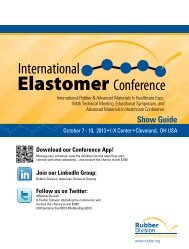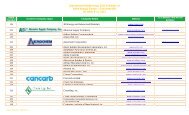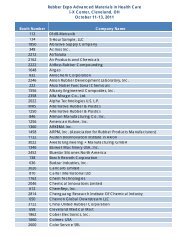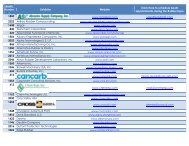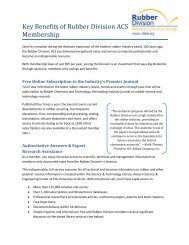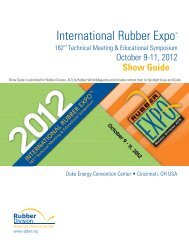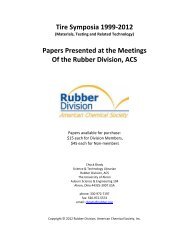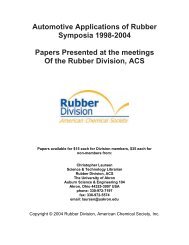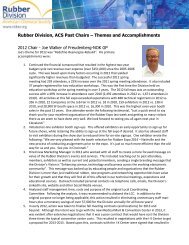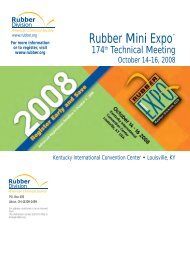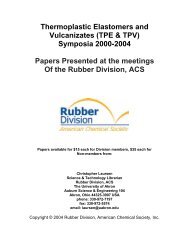Training Directory - Rubber Division
Training Directory - Rubber Division
Training Directory - Rubber Division
Create successful ePaper yourself
Turn your PDF publications into a flip-book with our unique Google optimized e-Paper software.
MANUFACTURING & PROCESSING<br />
Compounding, Mixing, Curing<br />
and Testing of <strong>Rubber</strong><br />
12 hours<br />
CEUs: 1.2<br />
This two-day course covers an Introduction to Polymer Science:<br />
NR, SBR and Polybutadiene <strong>Rubber</strong>; and Introduction to<br />
Compounding: Mixing, Carbon Black, Vulcanization, Specialty<br />
Elastomers, Tack and Adhesion; and the Physical Testing of<br />
Elastomer Procedures and Signifi cance. There is also a group<br />
discussion and problem solving session.<br />
Anyone interested in an introductory seminar on rubber<br />
should attend.<br />
Introduction to <strong>Rubber</strong> Technology<br />
for Non-Technologists<br />
4 RUBBER DIVISON, ACS EDUCATION OPPORTUNITIES<br />
8 hours<br />
CEUs: .8<br />
If you are new to the industry, working in Engineering, Sales,<br />
Administration, Human Resources or any other non-technical<br />
area, and you’d like a very basic, easy to understand introduction<br />
to the jargon of the trade and what goes on in the factory and<br />
lab, then this one-day course is perfect for you. You won’t come<br />
out a rubber expert, but you will understand all the basics of the<br />
technology and the language of the business.<br />
The course material will cover:<br />
• What polymers are, how rubber is different from plastic<br />
• How recipes for rubber compounds are created and why<br />
• What’s involved in mixing, processing and vulcanizing rubber<br />
• Testing, specifying and quality control of rubber products<br />
Cure Chemistry for <strong>Rubber</strong><br />
7 hours<br />
CEUs: .7<br />
This course will be a comprehensive review on the chemistry of<br />
rubber curing. It will include sulfur curing along with the majority<br />
of the common and not so common curatives types. Next will be a<br />
section on sulfur donors and their effect on the curing chemistry.<br />
Then peroxide curing will be covered, including the common<br />
available peroxides with their advantages and disadvantages<br />
along with a short section on co-agents. Finally, there will be<br />
sections on unconventional cure systems including resins cures<br />
and other unique cure chemistries.<br />
Equipment Selection & Technical<br />
Evaluation<br />
8 hours<br />
CEUs: .8<br />
Our equipment analysis portfolio provides a thorough examination<br />
of injection molding equipment to meet the requirements of the<br />
client’s application. Clients gain a competitive edge during the<br />
equipment acquisition phase, ultimately improving build efficiency<br />
while maintaining cost control.<br />
<strong>Rubber</strong> Processing<br />
7 hours<br />
CEUs: .7<br />
This seminar will deal with both theory and its application to<br />
practice, and the text used with this seminar will give references<br />
to the literature, which will enable those interested to dig deeper<br />
into any specifi c topic. There will be sessions on: Raw Materials<br />
Acceptance and Testing; Mixing; Milling and Calendering;<br />
Extrusion; Molding; Curing; and Processability Testing.<br />
Elastomer Molding Technology<br />
8 hours<br />
CEUs: .8<br />
This seminar describes and compares important molding methods<br />
(compression, transfer and injection) for thermoseting elastomers<br />
(TSEs) with methods (injection and blow) for thermoplastic elastomers<br />
(TPEs). Injection in molding is emphasized because it is the major<br />
molding method common to both elastomers. Injection molding<br />
machines and their characteristics will also be described and<br />
compared. Finally, there will be a limited description of mold<br />
design for TSEs and TPEs.<br />
This introductory course will benefi t people involved in molding<br />
both types of elastomers, especially those transitioning from<br />
molding of one type of elastomer to another. Attendees with<br />
primarly a materials-related background will improve their<br />
understanding of molding processes and the effect of mold design<br />
on molded products. Process and design managers will better<br />
understand the effect and importance of these factors<br />
on the overall molding operation.<br />
Attendees will improve their understanding of molding behavior<br />
of TSEs and TPEs and thus improve and better control their<br />
elastomer molding operations. The interdisciplinary approach<br />
used will assist them in understanding molding as an integrated<br />
operation consisting of materials, processes and design. The book<br />
“Elastomer Molding Technology” authored by John Sommer will<br />
be distributed and used in conjunction with the seminar.



